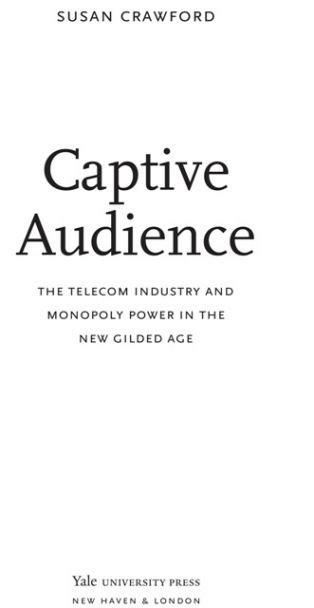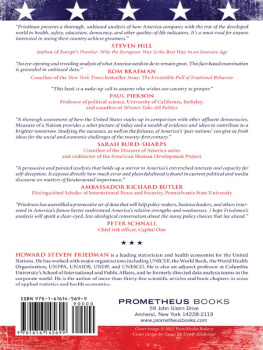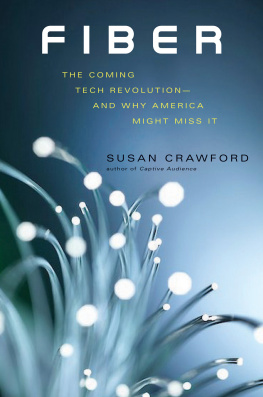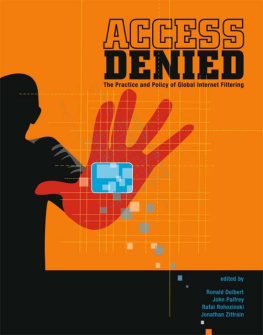

 Copyright 2013 by Susan Crawford. All rights reserved. This book may not be reproduced, in whole or in part, including illustrations, in any form (beyond that copying permitted by Sections 107 and 108 of the U.S. Copyright Law and except by reviewers for the public press), without written permission from the publishers. Yale University Press books may be purchased in quantity for educat (U.S. office). office).
Copyright 2013 by Susan Crawford. All rights reserved. This book may not be reproduced, in whole or in part, including illustrations, in any form (beyond that copying permitted by Sections 107 and 108 of the U.S. Copyright Law and except by reviewers for the public press), without written permission from the publishers. Yale University Press books may be purchased in quantity for educat (U.S. office). office).
Set in Scala type by IDS Infotech, Ltd. Printed in the United States of America. Library of Congress Cataloging-in-Publication Data Crawford, Susan P., 1963 Captive audience: the telecom industry and monopoly power in the new gilded age / Susan Crawford. p. cm. Includes bibliographical references and index.
ISBN 978-0-300-15313-2 1. TelecommunicationLaw and legislationUnited States. 2. Antitrust lawUnited States. I. Title.
KF2765.C73 2013 384.0973dc23 2012024367 A catalogue record for this book is available from the British Library. This paper meets the requirements of ANSI/NISO Z39.481992 (Permanence of Paper). 10 9 8 7 6 5 4 3 2 1 To the next generation CONTENTSIntroduction ON A GRAY DAY IN FEBRUARY 2010 , Brian Roberts sat facing the Senate Judiciary Committee's Antitrust Subcommittee. The subcommittee was holding its first hearing on a proposed merger between two of the country's most powerful media companies, the cable distribution giant Comcast and the entertainment conglomerate NBC Universal (NBCU). Roberts, the chief executive officer of Comcast, was a calm and friendly witness that day, as he testified before the branch of government that had created the antitrust laws in the first place. If the merger were approved by the Justice Department's Antitrust Division and the Federal Communications Commission, Comcast's future as the largest vertically integrated distributor of information in the country would be assured.
Big mergers happen all the time in America. The importance of this one lay in the fact that Comcast was gaining strength as a monopoly provider of wired high-speed Internet access in the areas it served, while America was lagging far behind other countries when it came to the prices charged for and the speed and capability of this basic communications tool. At the same time, the Internet was becoming the common global medium, with a unique capacity to empower individuals, groups, businesses, and governments around the world collectively to change their economic, political, and social fates. With high-speed Internet access, a farmer in Missouri can instantly access weather conditions and crop prices while his high school children get a world class education; Native Americans on a remote reservation can have their eyes checked by a distant doctor and avoid the blindness associated with diabetes; entrepreneurs and small businesses in California, New York, and all the states in between can find inexpensive entry points into global markets. Communities can plan their own destinies. A decade earlier, the United States had led the world in adoption of Internet access.
By the time of the hearing, America had fallen behind most other industrialized nations: customers in rural and poorer areas were getting spotty service, while those in wealthier areas were paying much more for high-speed access than their counterparts in other countries. In most of Comcast's market territories, it was the only high speed access provider selling services at speeds that would be sufficient to satisfy Americans requirements in the near future. But the access Comcast sold was less useful than it could have been because the network had been designed to be contested among users in the same neighborhood (making speeds unreliable) and favored passive consuming uses (downloads) far more than active uploads. Meanwhile, the service that all Americans would need within five years (truly high-speed Internet access ranging from 100 Mbps, or megabits per second, to gigabit speeds over fiber-optic lines), the service that would allow symmetrical (same-speed) uploads and downloads and extensive use of online streaming video for a host of educational, medical, and economic purposes, was routinely available in other countries but could not be purchased at all in most parts of the United States. Through the merger, Comcast would become even more entrenched and powerful, with unconstrained ability to set prices and conditions for wired Internet access in the areas of the country it served. America would never catch up to the rest of the world if Comcast and its fellow cable distributors controlled truly high-speed wired Internet access.
Because the merger would allow Comcast to more effectively control key sports and other content that many Americans prized, Comcast's new amplified role as a programmertaken together with its ability to coordinate with its programming brethrenwould probably make content too expensive for any potential competing data distributor. Any new high-speed Internet access provider in Comcast territory would have to enter the market for content at the same time it incurred the heavy up front costs needed to provide wired Internet access. Entering two markets at once is extremely difficult. Competition would be unlikely, leaving Americans in Comcast's territories reliant on Comcast alone for truly high-speed wired Internet access. Indeed, by the time the Comcast-NBCU merger was announced at the end of 2009, Verizon, the only nationwide company installing globally competitive truly high-speed access across fiber-optic lines in America, had already signaled that it was planning to stop doing so. It was just too hard to compete with Comcast.
In turn, Comcast had no incentive to make the Internet access it did sell affordable, globally competitive in terms of its capabilities, or available to everyone within its territories. Nor did it have any incentive to upgrade the networks it had built to fiber optics; the company was ready to reap the rewards of dominance. Truly high-speed wired Internet access is as basic to innovation, economic growth, social communication, and the country's competitiveness as electricity was a century ago, but a limited number of Americans have access to it, many can't afford it, and the country has handed control of it over to Comcast and a few other companies. It gets worse. Think of Comcast as an operator of a giant waterworks, with a connection to each home in the communities it serves. Some of the water it delivers is made up of traditional digital cable channels, and some of it is Internet access.
But all of it is data flowing down a single conduit: Comcast's business is carrying digital communications through a wire. A water carrier does not own the water itself. In this merger, however, Comcast was seeking to own the content it provided. This set up a huge conflict of interest: even as the Internet was becoming the world's general-purpose network, the merger would put Comcast in a prime position to be the unchallenged provider of everythingall data, all information, all entertainmentflowing over the wires in its market areas. The company would have every incentive to squeeze online services that were unwilling to pay the freight to Comcast. The future of the Internet itself in America as well as the terms on which Americans would be able to buy wired Internet access would be radically affected by the merger decision.
Although approval of the merger was technically up to the Justice Department's Antitrust Division and the Federal Communications Commission (FCC), the Senate subcommittee was hardly irrelevant. It represented the branch of government that oversees the budgets of the agencies charged with implementing the antitrust laws. But there were other reasons the subcommittee's role was important: the political questions inherent in any major mergerWill it create or destroy jobs? Is the merging company viewed as a good corporate citizen with a friendly relationship with unions? Does the company have a diverse workforce? Is the merger too big to bear?always come to Congress as a flurry of private meetings and one-page lists of factoids and talking points. Congressional political pressure (or lack of it) is relevant to the Justice Department and the FCC, even if both organizations deny that politics has anything to do with their expert administrative merger review. The hearing was relevant to the optics of the deal. As Comcast's chief executive officer, chair, and president, Roberts was the first witness.
Next page









 Copyright 2013 by Susan Crawford. All rights reserved. This book may not be reproduced, in whole or in part, including illustrations, in any form (beyond that copying permitted by Sections 107 and 108 of the U.S. Copyright Law and except by reviewers for the public press), without written permission from the publishers. Yale University Press books may be purchased in quantity for educat (U.S. office). office).
Copyright 2013 by Susan Crawford. All rights reserved. This book may not be reproduced, in whole or in part, including illustrations, in any form (beyond that copying permitted by Sections 107 and 108 of the U.S. Copyright Law and except by reviewers for the public press), without written permission from the publishers. Yale University Press books may be purchased in quantity for educat (U.S. office). office).